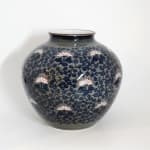Imaizumi Imaemon XIII 十三代今泉今右衛門
H21.3 x Dia21.5 x Lip Dia 10.4cm
Designated LNT in 1989
Further images
-
(View a larger image of thumbnail 1
)

-
(View a larger image of thumbnail 2
)

-
(View a larger image of thumbnail 3
)

-
(View a larger image of thumbnail 4
)

-
(View a larger image of thumbnail 5
)

-
(View a larger image of thumbnail 6
)

-
(View a larger image of thumbnail 7
)

-
(View a larger image of thumbnail 8
)

-
(View a larger image of thumbnail 9
)

-
(View a larger image of thumbnail 10
)

-
(View a larger image of thumbnail 11
)

The texture of paper; the quality of ink. These elements were core to Imaizumi Imaemon XIII’s classical porcelain works of art. As the thirteenth generation of a historical family of potters, Imaizumi Imaemon XIII’s understanding of the classical elements of Japanese art is foregrounded by a deep understanding of the subtlety and graceful qualities of Japanese Sumi-e painting.
Imaizumi Imaemon XIII was a descendant of the family who were initially decorators in the Nabeshima Daimyo kiln at Okawachi in Kyushu and he was designated in 1989 for his contribution to on-glaze enamel decoration (iro-e jiki). Much of the work of the Imaizumi family is red and blue enamels on a white background but Imaemon XIII has often experimented with a dark grey underglaze, sprayed, Uranium oxide ground (uzuzumi) and placed the on-glaze decoration against it. This background is reminiscent of the better-known sprayed Cobalt ground (fukuzumi) and is the signature technique of Imaizumi Imaemon XIII. The vase in the exhibition is a fine example of this unique technique.
Here, he glazes the blank porcelain surface with a textured background- as though priming a canvas- before painting on a meticulous decorative pattern of flora and fauna. The resulting effect on his Nabeshima porcelain is a slight drop shadow of the painted pattern as though the dark outlines of his adornments are relief forms that are raised from the paper-like porcelain surface. This illusory three-dimensional technique is subtle, and demands slow-looking from the viewer. For this precise technique, he was awarded the title of Living National Treasure in 1989.










